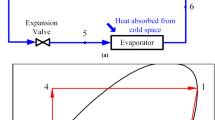Abstract
Based on the “hypothetical throat area” theory and the “constant-pressure mixing” theory, a thermodynamic model for ejector was set up by introducing the real properties of refrigerants. Refrigerants which have similar normal boiling points with each other may act as replacement to each other in substitute progress. In this paper, eight environment-friendly refrigerants were divided into 4 pairs for study according to their normal boiling point. In each refrigerant pair, the entrainment ratios of ejector, system COP, pump power et al. of refrigerants were compared and analyzed. Lastly, the performances of the transcritical and subcritical ejector refrigeration cycles with propylene were calculated and compared.













Similar content being viewed by others
Abbreviations
- A :
-
Area (m2)
- COP :
-
Coefficient of performance
- GWP :
-
Global warming potential
- h :
-
Specific enthalpy (J kg−1)
- k :
-
Ratio of specific heat
- m :
-
Mass flow rate (kg s−1)
- NBP :
-
Normal boiling point
- ODP :
-
Ozone depletion potential
- p :
-
Pressure (Pa)
- Q :
-
Rate of heat transfer (W)
- s :
-
Specific entropy (J kg−1 K−1)
- T :
-
Temperature (K)
- v :
-
Specific volume (m3 kg−1)
- W p :
-
Work rate of the pump (W)
- w :
-
Velocity (m s−1)
- c:
-
Condenser
- d:
-
Diffuser of ejector
- e:
-
Evaporator
- ef:
-
Entrained flow
- g:
-
Generator
- gf:
-
Primary flow
- m:
-
Mixing chamber of ejector
- s:
-
Isentropic process
- t:
-
Throat
- 1-6:
-
State points
- η :
-
Efficiency
- ρ :
-
Density (kg m−3)
- φ m :
-
Mixing coefficient
- ω:
-
Entrainment ratio
- ϕ g :
-
Ejector characteristic area ratio
References
Sun DW (1998) Comparative study of the performance of an ejector refrigeration cycle operating with various refrigerants. Energy Convers Manag 40:873–874
Selvaraju A, Mani A (2004) Analysis of a vapour ejector refrigeration system with environment friendly refrigerants. Int J Therm Sci 43:915–921
Angelino G, Invernizzi C (2008) Thermodynamic optimization of ejector actuated refrigerating cycles. Int J Refrig 3:453–463
Cizungu K, Mani A, Groll M (2001) Performance comparison of vapour jet refrigeration system with environment friendly working fluids. Appl Therm Eng 21:585–598
Dorantes R, Lallemand A (1995) Prediction of performance of a jet cooling system operating with pure refrigerants or non-azeotropic mixtures. Int J Refrig 18:21–30
Zhang YF (2007) Investigation on performance of ejector and optimal refrigerants for solar ejector refrigeration system. Acta Energ Sol Sin 28:130–136
Munday T, Bagster J, David F (1977) A new ejector theory applied to steam jet refrigeration. Ind Eng Chem Process Des Dev 16:429–436
Keenan JH, Neumann EP, Lustwerk F (1951) An investigation of ejector design by analysis and experiment. J Appl Mech 17:299–309
Henzler JJ (1983) Design of ejectors for single-phase material systems. Ger Chem Eng 6:292–300
Huang BJ, Jiang CB, Wang CP, Petrenko VA (1999) A 1-D analysis of ejector performance. Int J Refrig 22:354–364
REFPROP (2002) Thermodynamic properties of refrigerant mixtures, Version 7. National Institute of Standards and Technology, New York
Acknowledgments
The present study was supported by the project of National Natural Science Foundation of China (No. 51406228) and was supported by the Fundamental Research Funds for the Central Universities (2012QNA55).
Author information
Authors and Affiliations
Corresponding author
Rights and permissions
About this article
Cite this article
Wang, F., Shen, S.Q. & Li, D.Y. Evaluation on environment-friendly refrigerants with similar normal boiling points in ejector refrigeration system. Heat Mass Transfer 51, 965–972 (2015). https://doi.org/10.1007/s00231-014-1468-0
Received:
Accepted:
Published:
Issue Date:
DOI: https://doi.org/10.1007/s00231-014-1468-0



